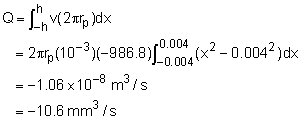| Ch 8. Incompressible and Viscous Flow | Multimedia Engineering Fluids | ||||||
|
Flow between Parallel Plates |
Couette Flow |
Viscous Flow in Pipe |
|||||
| Flow between Parallel Plates | Case Intro | Theory | Case Solution |
| Chapter |
| 1. Basics |
| 2. Fluid Statics |
| 3. Kinematics |
| 4. Laws (Integral) |
| 5. Laws (Diff.) |
| 6. Modeling/Similitude |
| 7. Inviscid |
| 8. Viscous |
| 9. External Flow |
| 10. Open-Channel |
| Appendix |
| Basic Math |
| Units |
| Basic Fluid Eqs |
| Water/Air Tables |
| Sections |
| eBooks |
| Dynamics |
| Fluids |
| Math |
| Mechanics |
| Statics |
| Thermodynamics |
| ©Kurt Gramoll |
| |
||
|
|
From the continuity equation, it can be concluded that the velocity v is a function of x only, i.e, v = v(x). The Navier-Stokes equations are simplified to The first and third equations require the pressure to be a function of y only. If the second equation is integrated twice (assumes dp/dy = constant with respect to x), then Applying the no-slip conditions to obtain the coefficients, and the above equation reduces to |
|
 Velocity Profile |
Note that h is one half of the gap width (h = 0.004 mm). Substituting the known values (i.e., μ = 0.38 N-s/m2, ρ = 912 kg/m3 and dp/dy = 15 MPa/20 mm), and the velocity profile becomes The volumetric flow rate of the leakage can be obtained by integrating the velocity over the cross sectional area as follows:
The negative sign simply indicates that the flow rate is in the negative y direction. Note: Students are encouraged to calculate the Reynolds number and determine if the assumption of laminar flow is valid. |
|


